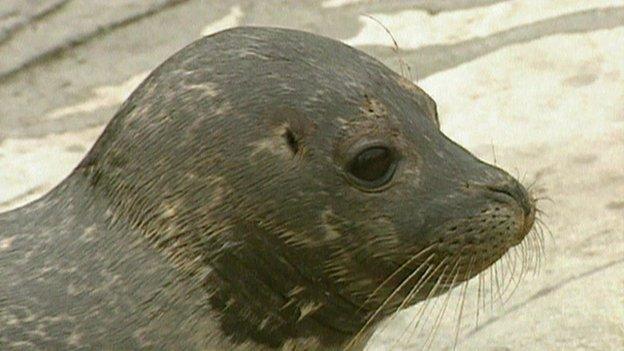'Corkscrew' seal deaths due to cannibalism not boats
- Published

A number of dead grey seals have been found with the mysterious spiral injury
Marine scientists have said they may have solved the mystery surrounding the deaths of seals whose carcasses were discovered with distinctive corkscrew wounds.
The finds sparked suggestions ships' propellers had struck them.
Researchers now think the injuries were caused during attacks by other seals, who ate their victims.
The Sea Mammal Research Unit (SMRU) observed a grey seal killing five young seals, leaving the spiral injuries.
Similar behaviour by seals has been recorded in Germany and scientists have suggested such attacks may be more common than previously thought. They believe it could explain the unusual clusters of injured seals found in Scottish waters.
Until now it was thought the animals had died after being caught in ships propellers because of the spiral cuts on their skin.
The injury has been described as a single, smooth-edged wound starting at the head and spiralling around the body.

The "corkscrew" injury had been attributed to contact with shipping
The SMRU, based at St Andrews University, was commissioned by Marine Scotland to investigate after 86 seal carcasses were found between 2009 and October 2014 with the distinctive markings.
A number of grey seals in the Firth of Forth were tagged to examine potential interactions with shipping and discover if any suffered the spiral injuries.
In December 2014 the scientists recorded an adult male seal on the Isle of May, in the Firth of Forth.
The SMRU said: "The Isle of May has been a hotspot for corkscrew injuries with multiple strandings recorded in 2010, 2012, 2013 and 2014."
Seal attack
The adult male seal was caught on camera attacking, attempting to drown, then killing and eating a weaned grey seal pup.
The SMRU described the attack: "It grabbed the pup by the scruff of the neck and dragged it over 20m to a shallow freshwater pool.
"The adult then climbed on top of the pup, forced its head under water and held it until its struggle subsided."
Over a period of 10 days the grey seal was observed killing five seal pups, and a further nine pup carcasses were found in locations where the adult had been sighted.
The seal was then traced by researchers to Denmark and Germany.
Of the 14 pups the researchers believe the adult male killed, 12 had the characteristics wounds that started at the head and spiralled down the body.
The report concluded: "The wound pattern seen on the grey seal pups at the Isle of May clearly resembled those that have been recorded as corkscrew wounds on previous grey and harbour seal cases in Scotland."
'Important evidence'
Marine Scotland said this new evidence does not completely eliminate ship propellers, but they are less likely to be a key factor. The government agency said it will continue to fund research into this issue to understand what caused these unusual deaths.
Environment Secretary Richard Lochhead said: "The clusters of corkscrew seal deaths were unusual and worrying.
"In common with many of the creatures that live in our seas, seals are animals that are loved by the public.
"It is very important that we understand what caused these unusual deaths and we now have important evidence that natural predatory behaviour is likely to be the main cause, rather than ship propeller injuries as we first thought."
He added: "Marine Scotland will continue to monitor our seal population for further injuries and any evidence about the causes."
- Published13 August 2010